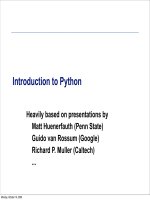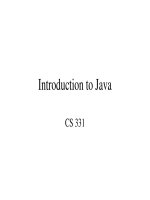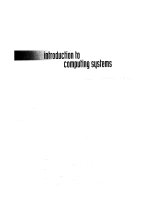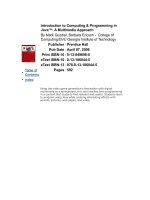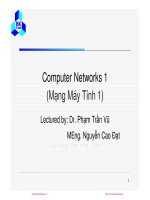Introduction to Computing: Lecture 12 - Dr. Pham Tran Vu
Bạn đang xem bản rút gọn của tài liệu. Xem và tải ngay bản đầy đủ của tài liệu tại đây (712.8 KB, 32 trang )
Introduction to Computing
Lectured by: Dr. Pham Tran Vu
1
Organisational and Social Issues
2
Social Issues
Computer waste and mistakes
Computer crime
Privacy
Health concerns
Ethical issues
Patent and copyright violations
3
Computer Waste
Discard technology
Unused systems
Personal use of corporate time and technology
4
Preventing Computer Waste and
Mistakes
Establish Policies and Procedures
Implement Policies and Procedures
Monitor Policies and Procedures
Review Policies and Procedures
5
Types of Computer-Related Mistakes
Data entry or capture errors
Errors in computer programs
Errors in handling files
Mishandling of computer output
Inadequate planning for and control of equipment
malfunctions
Inadequate planning for and control of environmental
difficulties
Installing computer capacity inadequate for the level of
activity on corporate web sites
Failure to provide access to the most current
information by not adding new and deleting old URL
6
links
Useful Policies to Eliminate Waste and
Mistakes
Changes to critical tables, HTML, URLs should be tightly
controlled, with all changes authorized by responsible
owners and documented
A user manual should be available that covers operating
procedures and that documents the management and
control of the application
Each system report should indicate its general content in its
title and specify the time and period it covers
The system should have controls to prevent invalid and
unreasonable data entry
Controls should exists to ensure that data input, HTML, and
URL are valid, applicable, and posted in the right time frame
User should implement proper procedures to ensure correct
input data
7
Computer Crime
8
Number of Incidents Reported to Computer
Emergency Response Team (CERT)
9
Computer Crime and Security Survey
10
The Computer as a Tool to Commit
Crime
Social engineering
E.g. pre-texting, phishing (email)
Dumpster diving
To get sensitive personal information such as address,
password, credit card numbers, etc.
Identity theft
Cyberterrorism
11
Computers as Objects of Crime
Illegal access and use
Hackers
Crackers
Information and equipment theft
Software and Internet piracy
Computer-related scams
International computer crime
12
How to Respond to a Security Incident
13
Data Alteration and Destruction
Virus
Worm
Logic bomb
Trojan horse
14
The Six Computer Incidents with the
Greatest Worldwide Economic Impact
15
Top Viruses – July 2002
16
Preventing Computer-Related Crime
Crime prevention by state and federal
agencies
Crime prevention by corporations
Public Key Infrastructure (PKI)
Biometrics
Anti-virus programs
17
Preventing Computer-Related Crime
Intrusion Detection Software
Managed Security Service Providers
(MSSPs)
Internet Laws for Libel and Protection of
Decency
18
Preventing Crime on the Internet
Develop effective Internet and security
policies
Use a stand-alone firewall with network
monitoring capabilities
Monitor managers and employees
Use Internet security specialists to perform
audits
19
Common Methods Used to Commit
Computer Crimes
20
How to Protect Your Corporate Data
from Hackers
21
Internet Security Threads
Viruses and hostile Web applications (e.g.
Java Applets or ActiveX controls)
Trojan horses
Adware and spyware
Spam emails
Identity theft and spoofing
Social engineering
22
Internet Security Measures
Firewall
Antivirus software
Email encryption
Encryption and authentication
Frequent updates of software
Always beware of incoming threads
23
Antivirus Software
Symantec: Norton Antivirus, Norton Internet
Security, etc.
McAfee: McAfee Virus Scan, McAfee
Internet Security, etc
Kaspersky
Bit defender
BKAV
…
24
Privacy
25
